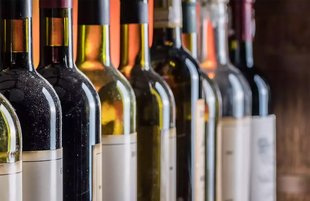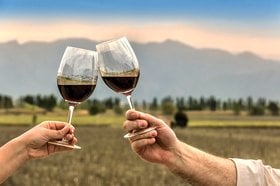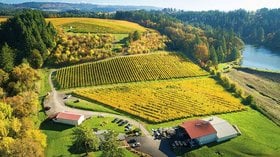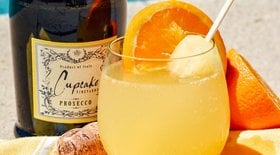Wine Descriptions: 70 Words To Describe Wine Like A Pro
Describing your wine using the right wine descriptions and tasting terms is an art in itself!
Let’s go through 70 words to describe wine, so you can shine at your next wine tasting event. To make it easier for you, we’ve classified them according to the wine’s origins and main characteristics.
Further reading
- Understand the different Wine Grapes - varieties and best bottles.
- Also, look at the Californian Wine Region - the different wine counties and top wines.
70 Wine Descriptions Used by Pros
If you’re a wine lover and just starting your wine journey, here are some terms to use at your next wine tasting.
We’ve classified the wine terms based on their origins and winemaking, main characteristics, tannins, aromas, flavors, and body structure.
Let’s start!
A. Wine Origins & Winemaking Terms

During a wine tasting, a wine expert or sommelier may use various terms that describe the winemaking process.
Let’s look at what they mean:
- ABV (Alcohol by Volume): It indicates the percentage of alcohol in a wine.
- Barrel Fermentation: In this wine production process, the wine is fermented in oak barrels to get a good balance and complex flavors.
- Blend: A blend indicates that a wine has a mix of several grape varieties or varietal wines. For example, you can make sparkling wine by blending different wines like Chardonnay and Pinot Gris.
- Fermentation: Fermentation involves the conversion of grape sugars to alcohol through the addition of yeast. It’s this process that converts grape juice into wine.
- Field Blend: This indicates a wine made from different grape varieties that have been harvested and vinified together.
- Late Harvest: Winemakers use the term ‘late harvest’ when they use grapes that were allowed to hang on the vine for a longer period. This concentrates the grape sugar, producing richer and sweeter wines.
- Lees: Lees are the dead yeast left in the wine after fermentation. They generally sink to the bottom of the bottle and give the wine a thicker, creamier texture.
- Malolactic Fermentation: It is a secondary fermentation process that takes place after alcoholic fermentation through special yeast cells. It converts the sharp malic acid to softer, palatable lactic acid and imparts a buttery flavor and texture to the wine.
- Terroir: This French word refers to the grape’s growing conditions, like the geographic location, soil type, climate, terrain, etc., that give the wine a unique character.
That’s why a Merlot from Napa Valley tastes different from a French Merlot wine.
- Variety, Varietal Wine: Variety denotes the type of grape, like Pinot Noir or Chenin Blanc. A varietal wine comes from a single grape variety (a Burgundian Pinot Noir.)
- Vintage: Vintage is a wine produced from the harvest of a specific year.
- Non-Vintage: Non-vintage (NV) wines are a blend of multiple vintages.
B. The Main Characteristics of Wine
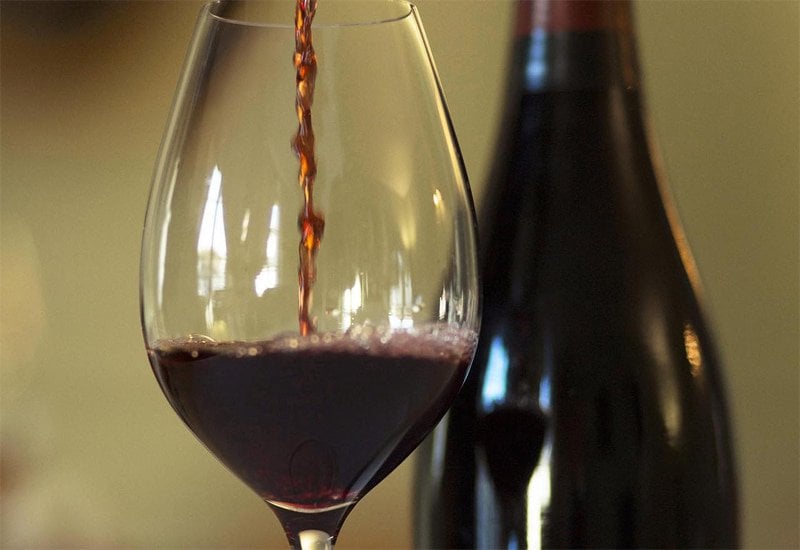
Here are a few wine terms that you can use to express how a wine feels when you take that first sip:
- Acidity: Acidity makes your mouth water and gives you a mouth-puckering feel, similar to what you get after eating a sour lemon. It makes a wine refreshing and zesty. This characteristic is essential for the perfect food and wine pairing.
- Alcohol: Alcohol results from the fermentation of the grape sugars by yeast cells. If a wine feels warm or hot in your throat, it’s due to higher alcohol content.
- Body: The body describes the weight and viscosity of the wine on the palate. A light bodied wine is more watery, while a full bodied wine has a consistency of whole milk.
- Complexity: A complex wine has various layered aromas, flavors, and nuances.
- Length: The length refers to the amount of time a wine’s flavor and texture stay on your palate after swallowing.
- Sweetness: When the winemaker stops the fermentation before all the sugar turns into alcohol, it results in a sweet wine.
This sweetness shouldn’t be confused with the perceived sweetness of a fruit forward wine.
- Tannins: Tannins are naturally occurring compounds in the grape skin that give the wine a bitter, dry feeling in the mouth - like when you steep the tea for too long.
C. Words to Describe Wine Tannins

You can use these words to describe the tannins in wine:
- Big: This term describes a wine with a massive flavor that occupies all of your mouth. A big wine can also mean big tannins.
- Chewy Tannins: Chewy tannin is a positive term that indicates that the wine has prominent but not overwhelming tannins.
- Grippy Tannins: A wine has grippy tannins when it has tannins that are pleasantly noticeable but not intrusive.
- Rough: It is a young wine with excessive tannins, which usually requires aging.
- Round: A round wine has a good balance of fruit and tannins and a good body.
- Soft: The word soft indicates a mellow, well-balanced wine with mature tannins and low acidity.
- Structured: This word describes a young wine with high tannins and acidity and is generally hard to drink. However, a structured wine softens up after a few years.
- Tannic: Tannic relates to a wine that has higher tannins (from the grape skin, stems, or oak), making it slightly bitter or astringent in taste. This term is generally associated with a young red wine like Cabernet Sauvignon, Syrah, and Nebbiolo since the grape skin is left intact during the fermentation of the red wine.
D. Wine Aromas
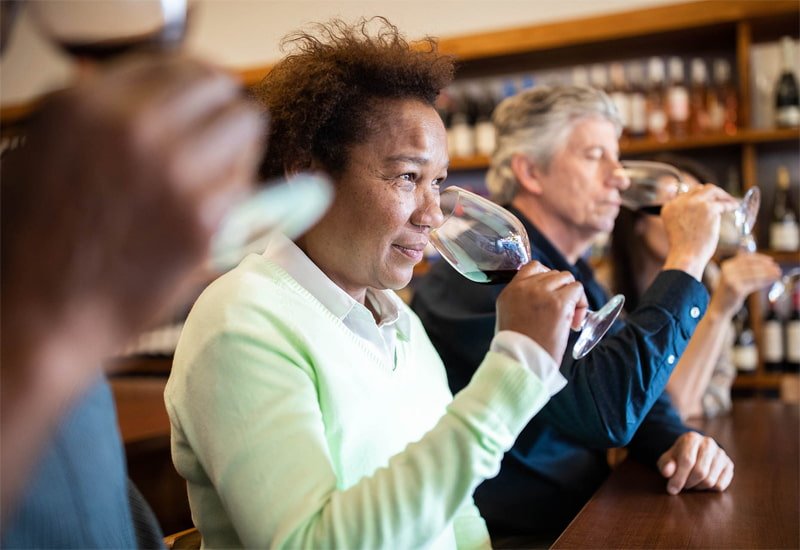
These terms will help you understand what process results in a specific wine aroma:
- Bouquet: A bouquet is the nose of the wine. A complex bouquet indicates maturity in a good wine.
- Primary Aroma: A primary wine aroma is mainly derived from grapes and includes dominant fruity, floral, and herbal notes.
- Secondary Aromas: These are background aromas resulting from the winemaking techniques such as fermentation. These may include a cheese rind, buttered brioche, nutty, or yeasty aroma.
- Tertiary Aromas: Tertiary aromas arise due to the aging process, like oak barrel aging, and may include coconut, vanilla, toasted nuts, leather, tobacco, or cigar box notes.
E. Words To Describe Wine Flavors
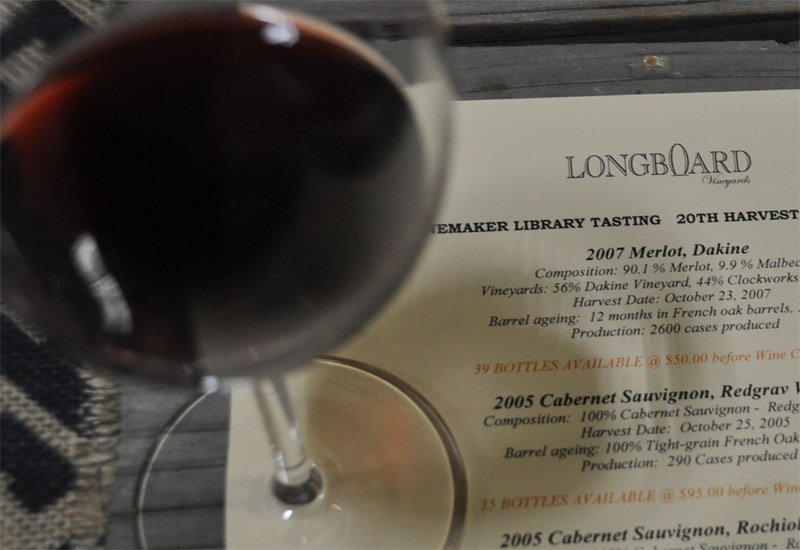
There are tons of words to characterize wine flavor. These wine terms will help you put your thoughts into words:
- Bright: A bright wine has a higher acidity and makes your mouth water.
- Buttery: A buttery wine has a creamy texture and a smooth finish resulting from oak aging.
- Cassis: Cassis indicates that the wine has a ripe, concentrated black currant tasting note and its seedy, gritty character.
- Cigar Box: A wine writer uses this to describe fine wines with cedarwood hints and lots of smoke.
- Creamy: This wine term describes the texture of a white and sparkling wine that has been aged or fermented in oak and undergone malolactic fermentation.
If you like a buttery wine, look for a creamy Chardonnay, and if you’re looking for a smooth wine type, you can opt for a creamy Cabernet Sauvignon.
- Dry: A dry wine has minimal residual sugar, which gives it a puckering sensation in the mouth.
- Earthy: Wine drinkers use this wine terminology to indicate that the wine has flavors and odors that remind you of a damp forest floor, mushrooms, wet leaves, and similar earthy notes.
- Elegant: Elegant wines are graceful and refined. They don’t reveal the bouquet of aromas and flavors simultaneously but evolve slowly on the palate.
- Flamboyant: Flamboyant wines typically have dominant fruit flavors.
- Fruit-forward: Fruit-forward indicates that the wine has a dominant fruit flavor like strawberries and baked apples. Their fruity flavor generally makes them easy to drink.
- Herbaceous: In wine tasting, this term is used when a wine has pepper, oregano, mint, eucalyptus, dried herb, or a similar flavor and aroma. For example, the Loire Valley Cabernet Franc has aromas of green pepper.
- Hint Of: A “hint of” refers to a subtle note in wine that doesn’t dominate the palate or nose. A wine can have a hint of oak, herbs, soil, petrol, etc.
- Jammy: In wine, jammy denotes a syrupy wine with a cooked berry sweetness. You can use it to describe wines like Zinfandel, Cabernet Franc, Australian Shiraz, and Grenache.
- Minerally/Minerality: These wine tasting notes are used when describing a wine that has a smell and taste of slate, wet stone, chalk, rocks, etc.
- Oxidized: A wine gets oxidized when overexposed to oxygen, which converts the alcohol into acetic acid. The term is usually used to denote a fault in the wine.
- Racy: Racy describes a vivid but light wine with noticeable acidity.
- Savory: Savory wines have more earthy and herbaceous character and less fruity characteristics.
- Silky:Silky defines the wine’s well-rounded, smooth finish.
- Smokey: A wine gives off smokey aromas when matured in a moderately charred oak barrel.
- Spicy: A spicy wine has baking spices, curry spices, black or white pepper notes.
- Tart: This term describes an unripe, green wine.
- Toasty/Oaked: You can use these terms to describe a wine with vanilla, caramel, smoke, or nutty aroma imparted by oak barrel aging.
- Tropical Fruit: White wines from warmer climates like California and Chile have tropical fruit notes like papaya, pineapple, and passion fruit.
- Unctuous: Unctuous describes luscious wines that are oily and hit the middle of your tongue.
- Unoaked: A wine that doesn’t undergo oak fermentation or aging is described as unoaked. An unoaked white wine has more lemony flavors, while an unoaked red has tart notes. They may also have earthy or jammy notes, depending on the grape.
- Vanilla: A wine drinker often describes the scent of new oak in the wine as a vanilla tasting note.
- Zesty: This term is used for lively, crisp wines with significant acidity and citrus notes. These mainly include white wines like Chenin Blanc, Sauvignon Blanc, and Pinot Grigio.
F. Terms To Describe Wine Body

These wine terms describe how a wine feels in your mouth:
- Angular: An angular wine’s taste profile is lean and sharp, hitting the mouth in some specific places with high acidity. It doesn’t taste very welcoming.
- Approachable: An approachable wine is an easy-to-drink wine.
- Balanced: A balanced wine has seamlessly blended elements - alcohol, tannins, acid, and sugars.
- Crisp: The term crisp is typically used to describe a fresh white wine like unoaked Chardonnay that has generous acidity.
- Dense: Dense is used to define a bold red wine like Cabernet Sauvignon that has concentrated notes.
- Flabby: Flabby refers to a wine that doesn’t have any acidity to balance it well - typically an unimpressive wine.
- Full-bodied: A full bodied wine has a higher viscosity and fills your palate with intense flavors and texture. They generally have higher tannins and alcohol and may also be described as rich, structured, opulent, or muscular.
A full bodied red wine like the French Bordeaux has complex flavors and firmer tannins, while full white wines like oaked Chardonnay have a round, creamy texture and tropical fruit and nutty flavors.
- Legs: Legs (tears of wine) are the tracks of liquid that cling to the sides of a glass after swirling the wine. Wine legs are caused by the evaporation of alcohol that affects the surface area of the liquid. That’s why more legs indicate a higher alcohol content in the wine.
- Light-Bodied: Light bodied wines are lighter in viscosity and have a delicate, subtle, or lean mouthfeel. They have less alcohol and tannins but higher acidity.
- Mouthfeel: This term describes how a wine feels on your palate - smooth, dry, velvety, rough.
- Supple: You can describe a wine as supple when it has a soft and round palate or a velvety texture. A supple wine has well-integrated tannins, so they’re not drying or astringent in the mouth.
- Velvety: If your wine is rich, soft, and smooth, you can use the term velvety to describe its character.
With this exhaustive list, you’re all set to describe wines like a professional!
Also, if you’re interested in building a portfolio of the world’s finest bottles, we have a great option for you:
Discover More of the Wonderful Wine World with Vinovest!
The world of wine is extensive, sensational, and offers something for every wine lover. It has easy-drinking casual wines as well as profitable, investment-grade wines to add to your portfolio.

Vinovest is an intelligent wine investment platform that helps you buy the right wine, store, and sell your favorite sparkling, white and red wines from all over the world.
